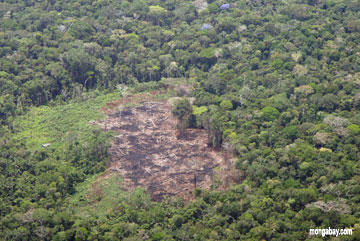Virgin rain forests of Costa Rica a misnomer
“Virgin” rain forests of Costa Rica a misnomer
Costa Rica’s forests have been widely burned by humans
mongabay.com
July 25, 2007
How long does it take to re-grow a rainforest after burning? New study suggests 170 years.
Radiocarbon dating of montane forest soils in Costa Rica uncovered evidence of charcoal that shows its otherwise “virgin” tropical forests are less than 200 years old. The findings, published in the journal Biotropica, have implications for the re-establishment of rain forests after clearing.
Documenting consistent presence of soil charcoal at every surveyed forest site from sea level to the highlands of Costa Rica, University of Denver biologists Beyhan Titiz and Robert L. Sanford Jr. propose that the Central American country’s forests “have been disturbed infrequently but multiple times as a consequence of anthropogenic and natural fires.”
The existence of fire is well-established in Latin American forests, both from natural causes like el Nino-induced climate events and volcanic eruptions, and more recently, human presence in the region. However the new research is intriguing because it both suggests that forest fires have been widespread in Costa Rica and that its tropical forests have recovered from multiple and extensive burns.

|
Noting that human populations in Central America have been “exploiting and modifying tropical forests” for the maize cultivation over the past 7,000 years, the researchers searched for and found maize pollen at various sites. Cross-referencing the ancient pollen with charcoal, the data suggests that “fire disturbance was a consequence of agricultural practices” in Costa Rica over at least the past 2,500 years. Further evidence is provided by greater abundance of charcoal at lowland sites than high elevation sites.
“Fire is largely a function of fuel—moisture content,” wrote the authors. “Lowland forests are moistures saturated whereas montane forests have higher variability in rainfall and are relatively more prone to dry periods… Consequently, more fires would be expected at higher elevations when a climate-induced drought occurs. The results of this study suggest the opposite with more abundant soil charcoal as evidence for increased lowland fires. These patterns then suggest there were periods of dry climatic episodes that facilitated human use of lowland forests, while at the higher elevations, dry
periods alone were not enough to start forest fires where humans population were not present.”
The research suggests that rain forests may be more resilient than previously believed, an important implication given that climate models forecast increased incidence of forest fires in many tropical forest regions as temperatures climb and precipitation patterns shift. Forest conversion for agriculture and deforestation and deforestation are expected to further exacerbate fire risk in the tropics.
CITATION: Beyhan Titiz and Robert L. Sanford Jr (2007). Soil Charcoal in Old-Growth Rain Forests from Sea Level to the Continental Divide. Biotropica Published online: 2-Jun-2007 doi: 10.1111/j.1744-7429.2007.00327.x
Related
Indigenous populations deforested New World rainforests before European contact. Indigenous populations used fire to clear large areas of tropical forest well before the arrival of Europeans reports a new study published in Annals of the Missouri Botanical Garden. The research has important implications for understanding the impact of present forest development on biodiversity and forest regeneration in the tropics.
Amazon rainforest fires date back thousands of years. Fires are nothing new to the Amazon reports a study published in the journal Biotropica. Analyzing soils in the interior of Guyana, South America, a team of scientists led by David S. Hammond of NWFS Consulting, has found evidence of forest fires dating back thousands of years. While the origin of these fires is unclear, the authors propose intriguing scenarios involving pre-Colombian human populations and ancient el Niño events which could have so dried rainforest areas that they became more prone to forest fires.